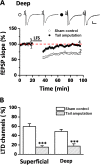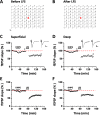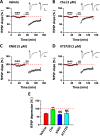Loss of long-term depression in the insular cortex after tail amputation in adult mice
- PMID: 24398034
- PMCID: PMC3912895
- DOI: 10.1186/1744-8069-10-1
Loss of long-term depression in the insular cortex after tail amputation in adult mice
Erratum in
-
Correction Notice.Mol Pain. 2017 Jan-Dec;13:1744806917711540. doi: 10.1177/1744806917711540. Mol Pain. 2017. PMID: 28478729 Free PMC article. No abstract available.
Abstract
The insular cortex (IC) is an important forebrain structure involved in pain perception and taste memory formation. Using a 64-channel multi-electrode array system, we recently identified and characterized two major forms of synaptic plasticity in the adult mouse IC: long-term potentiation (LTP) and long-term depression (LTD). In this study, we investigate injury-related metaplastic changes in insular synaptic plasticity after distal tail amputation. We found that tail amputation in adult mice produced a selective loss of low frequency stimulation-induced LTD in the IC, without affecting (RS)-3,5-dihydroxyphenylglycine (DHPG)-evoked LTD. The impaired insular LTD could be pharmacologically rescued by priming the IC slices with a lower dose of DHPG application, a form of metaplasticity which involves activation of protein kinase C but not protein kinase A or calcium/calmodulin-dependent protein kinase II. These findings provide important insights into the synaptic mechanisms of cortical changes after peripheral amputation and suggest that restoration of insular LTD may represent a novel therapeutic strategy against the synaptic dysfunctions underlying the pathophysiology of phantom pain.
Figures







Similar articles
-
Plasticity of metabotropic glutamate receptor-dependent long-term depression in the anterior cingulate cortex after amputation.J Neurosci. 2012 Aug 15;32(33):11318-29. doi: 10.1523/JNEUROSCI.0146-12.2012. J Neurosci. 2012. PMID: 22895715 Free PMC article.
-
Group I metabotropic glutamate receptors regulate the frequency-response function of hippocampal CA1 synapses for the induction of LTP and LTD.Eur J Neurosci. 2004 Jan;19(1):112-8. doi: 10.1111/j.1460-9568.2004.03103.x. Eur J Neurosci. 2004. PMID: 14750969
-
Long-term depression of synaptic transmission in the adult mouse insular cortex in vitro.Eur J Neurosci. 2013 Oct;38(8):3128-45. doi: 10.1111/ejn.12330. Epub 2013 Aug 11. Eur J Neurosci. 2013. PMID: 23930740
-
Interaction of DHPG-LTD and synaptic-LTD at senescent CA3-CA1 hippocampal synapses.Hippocampus. 2014 Apr;24(4):466-75. doi: 10.1002/hipo.22240. Epub 2014 Jan 14. Hippocampus. 2014. PMID: 24390964 Free PMC article.
-
Metabotropic Glutamate Receptor Dependent Cortical Plasticity in Chronic Pain.Curr Neuropharmacol. 2016;14(5):427-34. doi: 10.2174/1570159x13666150425002304. Curr Neuropharmacol. 2016. PMID: 27296638 Free PMC article. Review.
Cited by
-
Aberrant functional connectivity in insular subregions in somatic depression: a resting-state fMRI study.BMC Psychiatry. 2022 Feb 24;22(1):146. doi: 10.1186/s12888-022-03795-5. BMC Psychiatry. 2022. PMID: 35209866 Free PMC article.
-
Minocycline does not affect long-term potentiation in the anterior cingulate cortex of normal adult mice.Mol Pain. 2015 May 2;11:25. doi: 10.1186/s12990-015-0025-2. Mol Pain. 2015. PMID: 25933605 Free PMC article.
-
Loss of Synaptic Tagging in the Anterior Cingulate Cortex after Tail Amputation in Adult Mice.J Neurosci. 2018 Sep 12;38(37):8060-8070. doi: 10.1523/JNEUROSCI.0444-18.2018. Epub 2018 Jul 27. J Neurosci. 2018. PMID: 30054392 Free PMC article.
-
Adenylyl cyclase subtype 1 is essential for late-phase long term potentiation and spatial propagation of synaptic responses in the anterior cingulate cortex of adult mice.Mol Pain. 2014 Oct 10;10:65. doi: 10.1186/1744-8069-10-65. Mol Pain. 2014. PMID: 25304256 Free PMC article.
-
Neonatal Maternal Deprivation Enhances Presynaptic P2X7 Receptor Transmission in Insular Cortex in an Adult Rat Model of Visceral Hypersensitivity.CNS Neurosci Ther. 2017 Feb;23(2):145-154. doi: 10.1111/cns.12663. Epub 2016 Dec 15. CNS Neurosci Ther. 2017. PMID: 27976523 Free PMC article.
References
Publication types
MeSH terms
Substances
Grants and funding
LinkOut - more resources
Full Text Sources
Other Literature Sources

